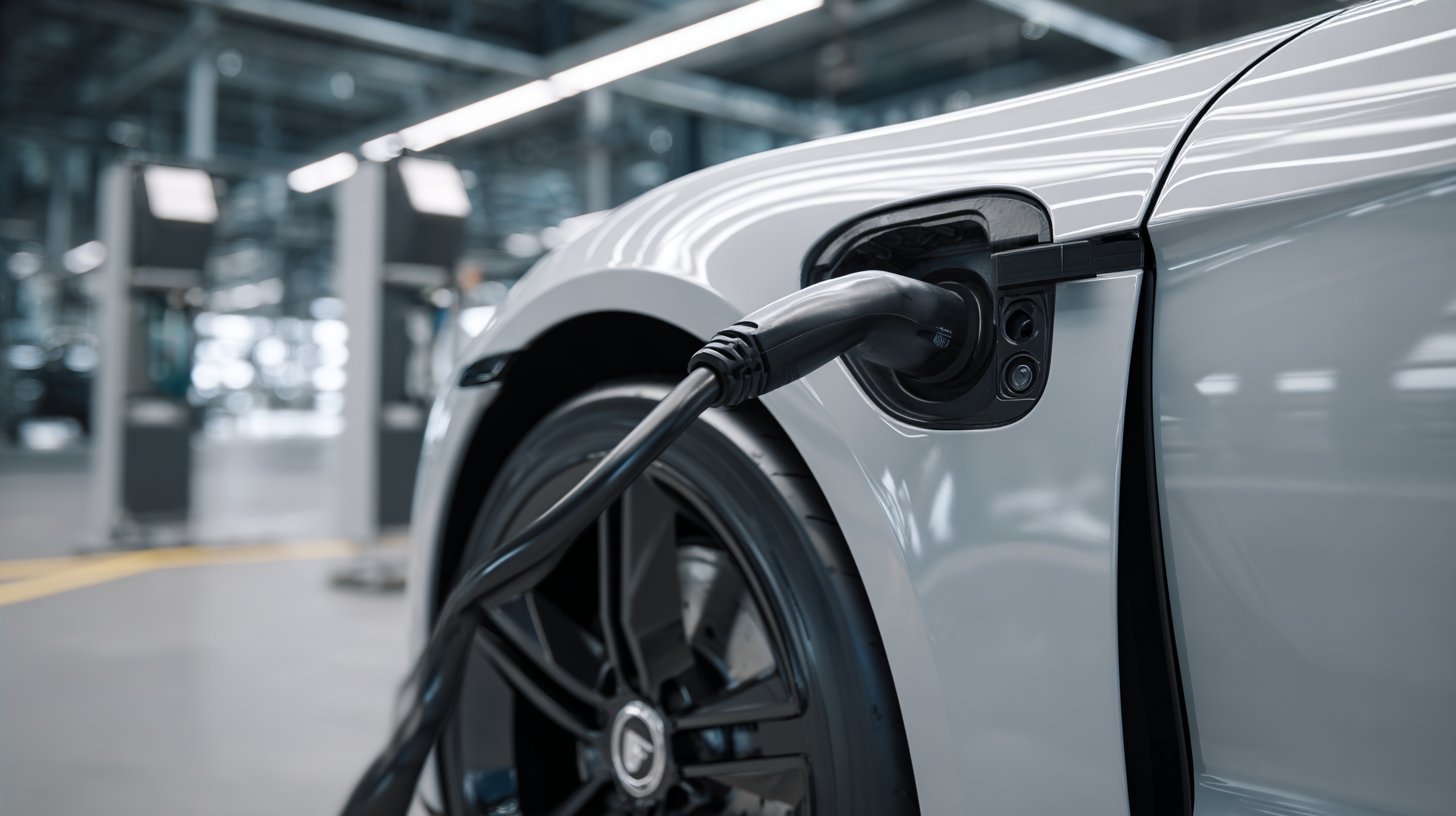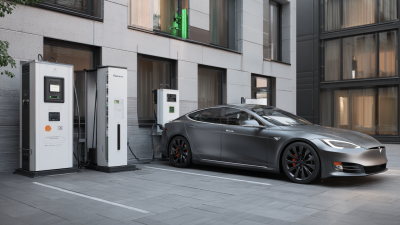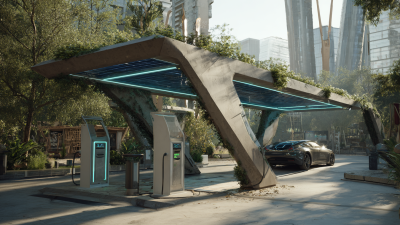
Wall Mounting EV Charge Station
Why You Need the Right EV Charging Cable for Your Electric Vehicle Today
As the electric vehicle (EV) market continues to expand rapidly, with forecasts predicting sales to exceed 26 million units globally by 2025, the importance of having the right EV charging cable has never been greater. According to a recent report by BloombergNEF, the demand for EV charging infrastructure will increase dramatically, with over 15 million public charging points expected to be installed worldwide in the next decade. This surge underscores the critical role that EV charging cables play in ensuring efficient and safe charging processes.

Selecting the appropriate EV charging cable not only impacts charging speed and efficiency but also ensures the longevity and performance of your electric vehicle. Inadequate cables can lead to overheating, voltage drops, and potentially hazardous situations. Industry experts emphasize that understanding the specifications and capabilities of different EV charging cables is crucial for optimizing charging solutions. As the transition to electric mobility accelerates, equipping yourself with the right tools, starting with a suitable EV charging cable, will ultimately enhance your EV ownership experience and contribute to a more sustainable future.
Understanding Different Types of EV Charging Cables for Your Electric Vehicle
When it comes to owning an electric vehicle (EV), understanding the different types of EV charging cables is crucial for optimal charging efficiency and safety. There are primarily three levels of EV charging: Level 1, Level 2, and DC fast charging (Level 3). Level 1 charging typically uses a standard 120-volt outlet and can take over 12 hours to fully charge a vehicle. In contrast, Level 2 charging stations, operating at 240 volts, can fully charge most EVs in 4-6 hours, making them the most common for home and public use. Lastly, DC fast chargers can provide up to 80% charge in as little as 30 minutes, ideal for long-distance travel.
**Tip:** When selecting a charging cable, ensure it matches your vehicle's charging port type—most EVs use either the J1772 or CCS connectors. This ensures compatibility and efficiency, allowing you to charge without any hassle.
It's also important to consider the cable's amperage. Standard Level 2 chargers typically range from 16 to 40 amps. According to the Electric Vehicle Association, cables with higher amperage allow for faster charging times, which can significantly reduce the time spent charging at home or on the go. Fostering an understanding of these variations helps you make informed choices regarding your charging setup and enhances your overall EV experience.
**Tip:** Always opt for cables that are certified and suitable for outdoor use if you plan to install a charging station outside, ensuring durability and safety in various weather conditions.
| Cable Type | Charging Level | Power Rating (kW) | Typical Use Case | Cable Length (meters) |
|---|---|---|---|---|
| Type 1 | Level 1 | 1.4 | Home Charging | 3-5 |
| Type 2 | Level 2 | 7.4 - 22 | Public Charging, Home Charging | 5-10 |
| CCS | Level 3 | 50 - 350 | Fast Charging | <1 |
| CHAdeMO | Level 3 | 50 | Fast Charging | <1 |
| Mobile Charging Cables | Level 1 & 2 | 2.4 - 32 | Convenience Charging | 1-10 |
Key Factors to Consider When Choosing an EV Charging Cable
When choosing the right EV charging cable for your electric vehicle, several key factors must be taken into account. First and foremost, compatibility is crucial. Different electric vehicles utilize various connectors and charging standards, so ensuring that your cable matches your vehicle’s requirements is essential for efficient charging. This avoids potential inconveniences or the risk of damage to your vehicle’s charging system.
Additionally, the charging speed is an important consideration. Charging cables come in different amperage ratings, which directly affect how quickly your EV can charge. Opting for a cable that supports higher amperages can significantly reduce charging time, making it more convenient for daily use. Furthermore, the cable's length should be evaluated based on your charging setup; longer cables offer flexibility in parking and positioning, while shorter cables may be easier to manage and store. With the global electric vehicle market expected to experience substantial growth in the coming years, selecting the right charging cable has become a vital aspect of owning an electric vehicle.
EV Charging Cable Preferences by Type
The Impact of Cable Length and Voltage on Charging Efficiency
When it comes to electric vehicle (EV) charging, the importance of using the right charging cable cannot be overstated. One critical factor influencing charging efficiency is the length of the charging cable. According to a study by the International Energy Agency, longer cables can lead to increased resistance, which diminishes the flow of electricity to the vehicle. This resistance can result in slower charging times, potentially extending the time it takes for EV owners to replenish their batteries fully. For example, a cable length exceeding 25 feet can reduce charging efficiency by up to 10%, which is significant for those relying on quick charging solutions.

Voltage is another pivotal aspect that affects charging efficiency. Most EVs operate optimally at a standard voltage of around 240 volts; however, using a cable that is not rated for this voltage can lead to underperformance. The Electric Power Research Institute states that using a cable rated for lower voltage can dramatically reduce the overall energy transfer, causing an increase in charging time and energy waste. Choosing the correct cable that matches the vehicle's specifications ensures that the maximum voltage is delivered, enhancing charging speed and efficiency. Hence, investing in the appropriate EV charging cable is essential for any electric vehicle owner looking to optimize their charging experience.
Safety Standards and Regulations for EV Charging Cables
When choosing an electric vehicle (EV) charging cable, understanding the safety standards and regulations that govern these products is essential. Different regions have established specific safety protocols to ensure that EV charging cables can handle the electrical loads they are designed for without posing risks of overheating or failure. Compliance with standards such as the IEC (International Electrotechnical Commission) guidelines or the UL (Underwriters Laboratories) certification not only provides assurance of quality but also helps prevent potential hazards, such as electrical shocks or fires.

Moreover, regulations often dictate the use of materials and construction techniques that enhance durability and reliability. Cables must be resistant to environmental conditions, including temperature variations, moisture, and UV exposure, which are crucial for both outdoor and indoor charging scenarios. Adhering to these standards guarantees that the charging cable you use will not only function properly but will also contribute to the overall safety of your EV charging experience. By ensuring compliance with local and international standards, EV owners can enjoy peace of mind, knowing their charging infrastructure meets rigorous safety requirements.
Future Trends in EV Charging Technology and Cable Innovations
As the electric vehicle (EV) market continues to expand, so too do the innovations in EV charging technology and cable design. One of the most notable trends is the development of ultra-fast charging solutions that reduce charging time significantly. Manufacturers are now focusing on higher power outputs, allowing vehicles to charge in as little as 20 minutes, making EV ownership more convenient and appealing. This shift is prompting the creation of cables that can handle increased voltage and amperage while ensuring safety and efficiency.
Additionally, wireless charging technology is gaining traction, offering a hassle-free alternative to traditional cable systems. This innovation not only enhances user convenience but also paves the way for smart cities with integrated charging solutions embedded into roadways. Alongside these advancements, there is an increasing emphasis on sustainability in cable materials, with a drive towards biodegradable and recyclable options. As the EV landscape evolves, these technological and material innovations are crucial for addressing consumer needs and paving the way for a greener future in transportation.
Related Posts
-

Ultimate Guide to Choosing the Best Ev Fast Charge Station for Your Business
-

Embracing Innovation: The Future of EV Charger Stations for Sustainable Transportation
-

7 Ultimate Benefits of Installing an EV Charger Station for Your Business
-

Ultimate Guide to Choosing the Right Ev Charger Station for Your Needs
-

Unlock the Future: How EV Charger Stations are Revolutionizing Sustainable Transportation
-

Exploring the Future of Mobility: How EV Charging Stations Are Transforming Urban Landscapes

